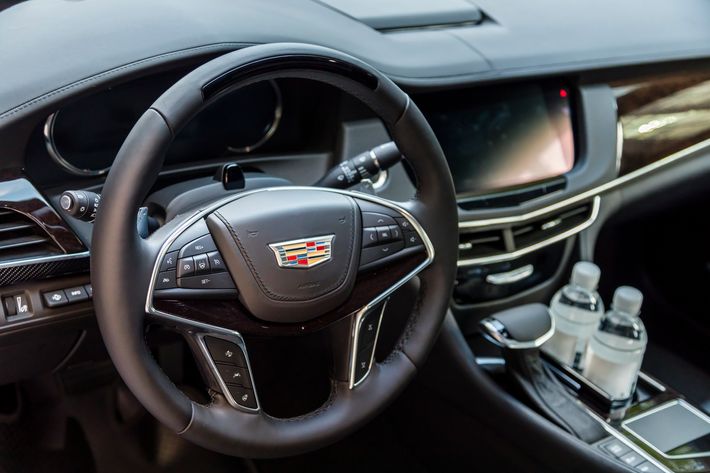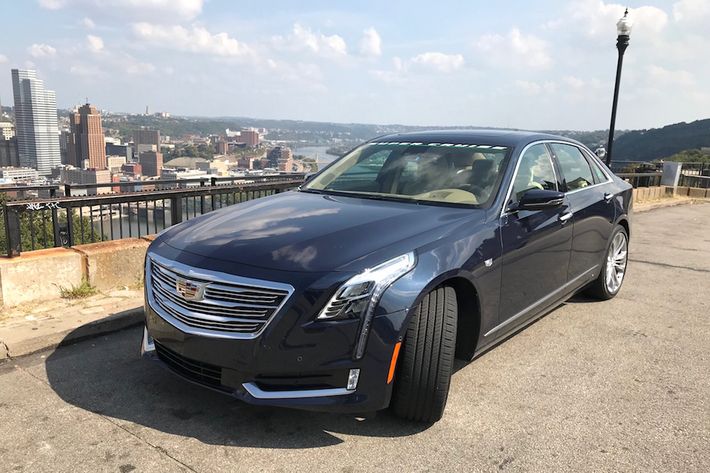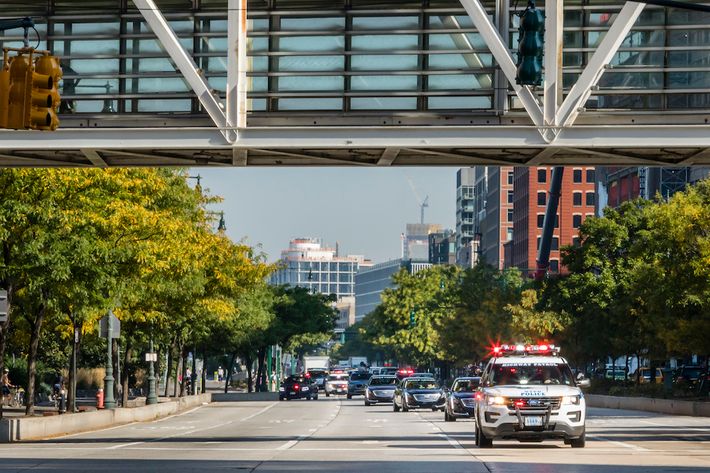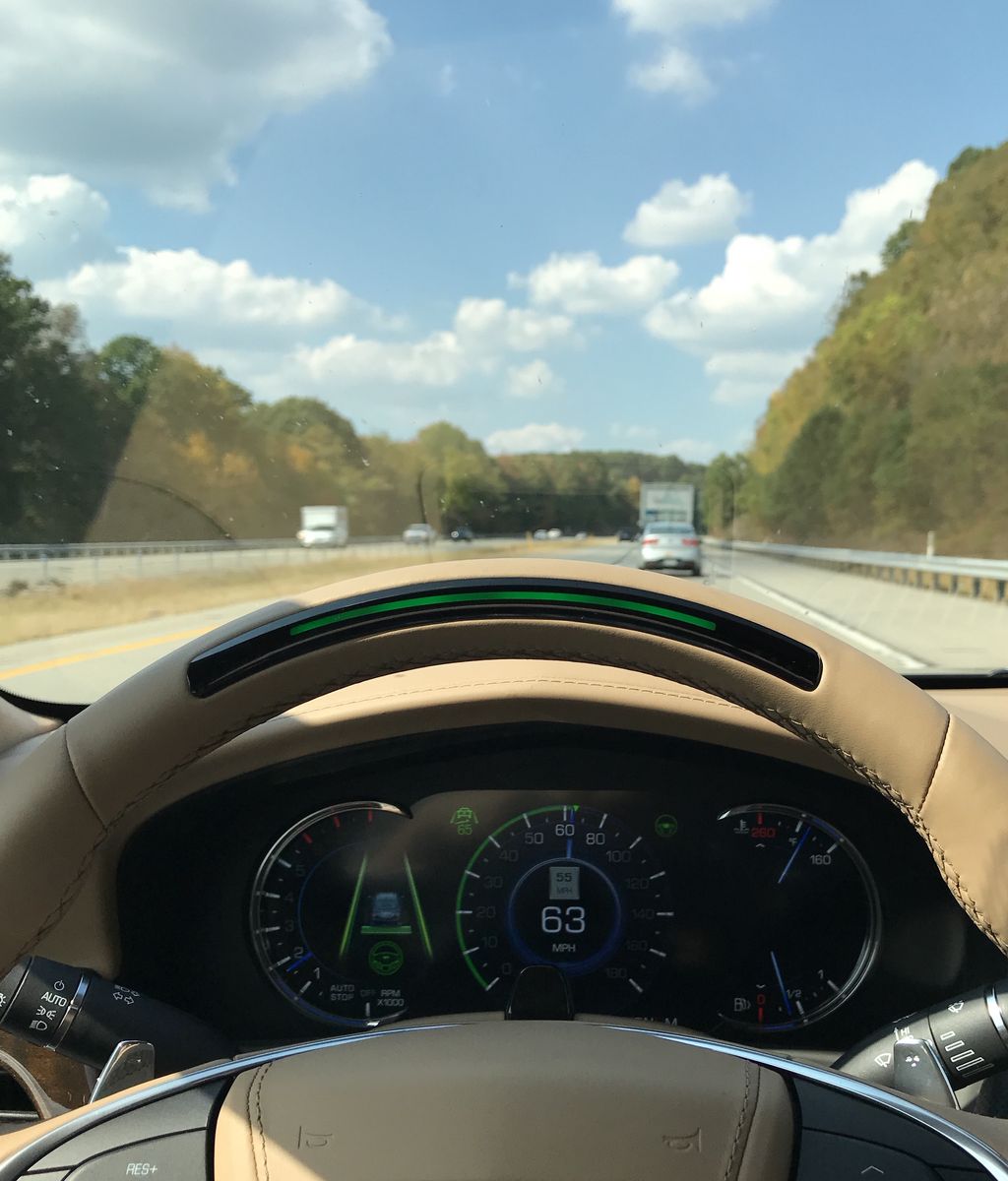Even in a $90,000 car, I-95 sucks to drive. Last week I found myself behind the wheel of Cadillac CT6 — priced at $88,295 — tearing down the unvariegated ugliness of the I-95 turnpike, watching my mirrors and adjusting my speed, waiting for the traffic to worsen. And then I pressed a button. The top of the steering wheel turned green. I removed my hands from the wheel. I took my feet off the pedals. The Cadillac was now driving itself, using a hands-free driving mode the company calls “Super Cruise.” And, for perhaps the first time in modern history, traveling on I-95 wasn’t quite so shitty.
There’s a fluttery thrill to testing out a hands-free car for the first time. In my day-to-day, I review smartphones, Wi-Fi routers, headphones, and other stuff that only moves quickly if you throw it really hard. Watching from the interior of a robot car as we take an inside corner at 70 miles per hour while an 18-wheeler rumbles along just a few feet away in the right lane is a bit different, even with my hands hovering like an anxious parent over the steering wheel. I am, after all, putting not only my own life at risk, but also the life of the journalist sitting next to me, the long-haul trucker in the other lane, and, if things should go badly awry, the drivers behind us.
But the CT6’s hands-free driving system follows the curve of the road better than I would. It senses and brakes for other cars merging in and out of traffic in front of me, even, at one point, neatly moving through the S-curve of a lane shift through the a small construction zone. And it handles, perhaps more importantly, my own inattentiveness. The CT6 is an autonomous driver who can take over for you. But it’s also, thankfully and annoyingly, an autonomous passenger reminding you to keep your eyes on the road.
The Society of Automotive Engineers has a six-level scheme to rank the advancement of automated vehicles. A Level Zero car is a Model T — nothing is automated, and you probably snap your arm using the crank lever to start the car. Level One cars have some automated features, like automatic braking systems or cruise control. In Level Two cars, both the speed and the steering can be controlled by the car, but a human needs to be present while these functions take place. Level Three, in which automation can handle most situations without human intervention or attention, is followed by Levels Four and Five: the promised land. When I imagine the future of universal self-driving cars, a landscape where bubbly Google Pods speed me through the world while I lean back and read a good book (or, more likely, my phone), those are Level Four or Level Five cars — no human intervention needed.
We still live in a Level One world, but Level Two is increasingly visible on the road. Cars with impressive “hands-free” modes — from a Tesla Model S with Autopilot to the Cadillac CT6 I was driving — are Level Two cars. So far, only the Audi A8, out next year, is willing to test the Level Three waters. (Generally, Level Three is seen as dangerous enough that most manufacturers are skipping it altogether, hoping that full autonomy is close enough that they don’t need to bother with it.) The important thing to note here is that in Level Two cars, human attention is required at all times: In 2017, if you buy a “self-driving” or “hands-free” car, what you are likely getting is a car that can control its speed, its distance from other cars, and keep you centered in a lane — but it wants you to watch while it does so.
Which is why Super Cruise is really two sensor systems, one on the outside and one on the inside. Outside the car: an HD camera in the front to sense the lanes, supplemented with an array of other cameras that give the car a 360-degree view of the road around you, and aided by precision GPS and a database of 160,000 miles of “limited use highways,” the only place the Super Cruise system will kick in. Or, in normal-person language, you can only use Super Cruise on highways with medians running down the middle and where you exit and enter via on ramps and off ramps. The Super Cruise is meant for the interstate, not the inner city.
But the CT6 isn’t just watching the road at all times. It’s also watching me. Inside the car is a sensor array meant for the driver: a camera (which, for the record, doesn’t store any footage) inside the steering wheel supplemented by infrared sensors. Just as the external camera is constantly monitoring the lanes and the the position of surrounding cars, the steering wheel is constantly monitoring my gaze and the position of my face. If I engage Super Cruise and let the car drive itself, and it the detects my eyes wandering to scenery — or, God forbid, my phone — Super Cruise issues a warning. Keep at it, and it disengages altogether. The car will drive itself, you but you gotta pay attention while it does it.
The reason your car needs to watch — and nag you — is fairly obvious. Last year, a Florida man named Joshua Brown became the first person to die in an automated car, when his Tesla crashed into a semitruck. Tesla’s Autopilot system was ultimately found to not be at fault in Brown’s death — it issued six audio warnings for him to place his hands back on the wheel — but Tesla has since been much more cautious in its rollout of the Autopilot program.
Cadillac’s solution for severe driver inattention is even more cautious (and the one that the NTSB strongly recommended auto makers institute). First, the car simply warns you that it’s disengaging Super Cruise. Then, it buzzes your seat. If you still don’t respond, it will contact OnStar and, potentially, summon medical help. (I wasn’t brave enough to test this; the thought of explaining to some square-jawed EMT that I was a blogger seeing whether my robot car could tell I was faking a heart attack was a bridge too far for me.) I haven’t used Tesla’s Autopilot, but according to a fellow journalist who had, even the way Super Cruise handled in normal circumstances felt safer — it took turns more slowly, gave more distance to other cars.

It also makes for a somewhat odd driving experience. For me, there was the initial fear, but it passed quickly; by the time you’re used to it, it’s more like watching a very dull movie — something Warholian about the interplay of sun, shadow, and the monotony of the interstate. Your attention wants to drift, but the car will start beeping at you. I found myself growing sleepy after a long stretch of doing nothing, sucking down shitty gas-station coffee like it was Gatorade. I snuck glances at my phone. It was relaxing, but relaxing in the way uninteresting dinner conversation can be relaxing — you’re free to mentally check out, let your thoughts wander around a bit. It’s not unpleasant. It’s not exciting. It’s just a very advanced piece of code doing something I could do for myself, while I sit quietly with my hands in my lap.
The system will kick drivers out of Super Cruise, depending on how fast the car is going, within about four seconds if the driver isn’t paying attention to the road. But all three of journalists that drove the CT6, including myself, quickly displayed that admirable human desire to fool systems put in place to keep us safe. We worked out ways to bounce our attention back and forth between our phone and the car in roughly four-second segments, deceiving the system into thinking we were paying attention, to the point where we were all able to answer emails and to Slack with co-workers. One journalist I was riding with was able to communicate with his editor, log in to Facebook, and then start a Facebook Live session of him driving hands-free. While I held the camera for the majority of the time, the fact he was able to coordinate that many moving parts while ostensibly driving a car is either impressive or incredibly stupid. (Most of the comments on the post, for what it’s worth, were variants of “Get the fuck out of the left lane and let people pass, idiot.”)
For the two days and 600 miles from New York to D.C. and then from D.C. to Cleveland, we probably spent almost a quarter of that time using Super Cruise. When it’s working, it’s an impressive glimpse of what automated driving can be. A car merged directly in front of me going dangerously slower than the flow of traffic around it. My instinct was to pump the brake and make a quick lane change to the left — a lane change that would have taken me into the path of a sedan speeding along in the passing lane. The car recognized everything going on, calmly decelerated, and then smoothly caught back up with the rest of the crowd.

But glimpses of the future are never perfect, and Super Cruise also had a host of small issues. Super Cruise ostensibly will turn off if it detects you’re not paying attention or there’s something up ahead that requires your attention, but in reality it could be capricious. I had the car suddenly kick me out of Super Cruise when my eyes were on the road and conditions appeared to be fine: no visible construction, no complicated lane changes or lane merges coming up, no tollbooth to slow down for. It would then become available again a few seconds later. There were also long periods where Super Cruise would go MIA. (When asked why Super Cruise would seemingly stop and start working, a spokesperson for Cadillac would only offer this: “There can sometimes be anomalies in the map or past construction zones. This is why we are continually remapping and pushing updates [over the air] to reduce such instances.”)
And I say this with some real shame: If money were no object, I would buy a car with Super Cruise tomorrow, and I would immediately use my phone in my car more. Partly because it would indulge that juvenile part of me that just enjoys getting away with things; knowing that Cadillac had a built-in monitor watching me, and knowing that I could outsmart that system, is as close to as a guy in his mid-30s gets to cutting civics class to go get high and play Xbox. And partly it’s because Super Cruise, rightly or wrongly, gives me some confidence I wouldn’t slam into another car or a bridge embankment while looking up fantasy football injury updates.
“People are texting anyways,” says Robb Bolio, vehicle performance manager for the Super Cruise. “This is gonna help, because the car is paying attention. We don’t condone it, but everywhere you look, people are texting. We will never condone that, but it’s safer than what they’re doing in their regular car, because the car is seeing what’s going on, and we do have this escalation process. Are people gonna trick the system, or figure out how to trick the system? Maybe.”
Bolio’s not wrong about people texting already. In the back of my Uber, headed back from the airport, I counted at least four people people staring at their phones while moving at highway speeds. None were driving a Cadillac CT6, so I’m guessing none had some version of Super Cruise engaged. Regular, nonautomated driving suddenly seemed terribly, terribly unsafe to me.
Ultimately, the Super Cruise is just a stepping-stone — or maybe a small detour — to a fully automated future. My first experience of driving with my hands off the wheel was mildly terrifying. Those first few close calls, when cars passed by too close, or I wondered if the car would suddenly decide to shoot off an off ramp into a gas station at 70 miles per hour, raised my heart rate. By the second day of the drive, though, I was enjoying the ability to take in the scenery while driving through the lovely Allegheny Valley, in a way that just isn’t possible in a car that isn’t driving itself. By the end of my second day of the future, I was just mainly annoyed when the Super Cruise failed to perform exactly how I wanted it to, when I wanted it to. Where was my Level Four robot chauffeur? I had gone from anxious to irked in less than 48 hours. The future, it starts to look so quickly like the past now.
Still, there was something to be said for the futuristic sheen of the self-driving technology, and its attention to keeping me safe. At the opening press conference in Cadillac’s gleaming new headquarters, in Soho, a convoy of CT6s stood outside, ready for journalists to get behind the wheel for their road trip (the cars will eventually make it all the way to California). State troopers stood around flashing their lights, ready to lead a convoy of very expensive sedans to the George Washington Bridge.

“What’s this all about?” asked a white-collar guy on a road bike as I waited by my car, indicating the cars, the cops, and the Cadillac camera crew swarming over everything.
“It’s the new Cadillac. It’s gonna be able to drive itself,” I said.
He eyed it for a second. “Man, lotta trust in a machine. That seems dangerous.” I wasn’t sure what to say. “Well, good luck!” he said, shooting across Vandam against a light and going the wrong way up a one-way street.






























